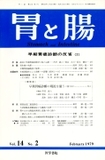Japanese
English
- 有料閲覧
- Abstract 文献概要
A 66-year-old man was well until March, 1975 when he developed hematemesis and melena. In July 1976, he developed right lower quadrant pain associated with a gradual weight loss.
On physical examination, he was noted to have a firm, mobile, egg-sized mass with a smooth surface and slight tenderness in the ileocecal region.
A 66-year-old man was well until March, 1975 when he developed hematemesis and melena. In July 1976, he developed right lower quadrant pain associated with a gradual weight loss.
On physical examination, he was noted to have a firm, mobile, egg-sized mass with a smooth surface and slight tenderness in the ileocecal region.
The patient was admitted to hospital for investigation.
Barium enema and barium meal follow-through studies revealed an irregular mucosal pattern in the terminal ileum with a fistula between the ileal loops. The radiological impression was probably Crohn's disease of the ileum. However, the possibility of tuberculosis or lymphoma could not be excluded.
Ileocecal resection was performed, because the possibility of malignancy was not entirely ruled out. The resected specimen demonstrated multiple irregular ulcers and erosions with an internal fistula between the loops of the terminal ileum.
Histologically, these ulcers were accompanied by non-specific inflammatory process with deeply undermined edges, penetrating through the muscularis. The floor of ulcer shows granulation tissues rich in vascularity, containing marked cellular infiltrates of lymphocytes, plasma cells, histiocytes, neutrophils and eosinophils. Foci of lymphoid tissues with hyperplastic germinal centers were seen scattered through the ileum near the ulcers. The histological pictures were not typical of Crohn's disease. Tuberculosis and other infectious etiology were unlikely.
Postoperatively, ESR did not improve 5 weeks after operation. Four months later, he developed diarrhea and abdominal pain along the operative suture line. Barium enema at that time revealed a recurrent disease on the ileal side of the anastomosis. He has since been placed on salazopyrin and predonisolone for one year and 8 months. He is now in clinical remission.
During the follow-up period, a suspicion of Behçet's disease was raised mainly because of the grossly undermined appearance of the ulcers. However, the patient has not yet shown other manifestations characteristic of Behçet's disease than occasionally seen aphthous stomatitis which can also be a complication of Crohn's disease.
It has been reported that those signs typical of Behçet's disease can appear later than intestinal ulceration on rare occasions. A long-term follow up would clarify the true nature of the disease on this patient.
Copyright © 1979, Igaku-Shoin Ltd. All rights reserved.


